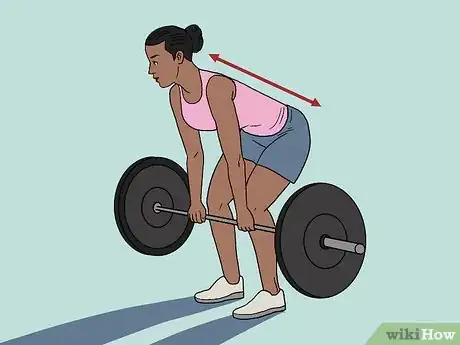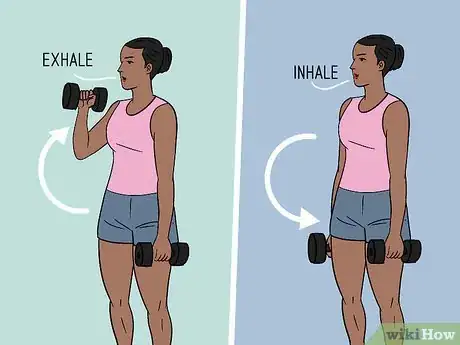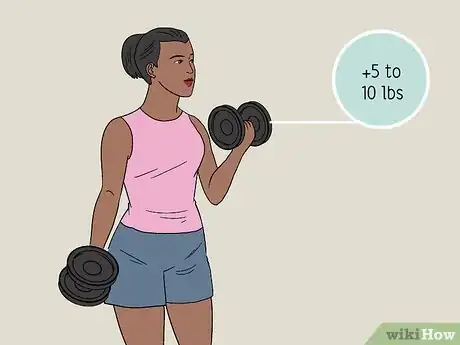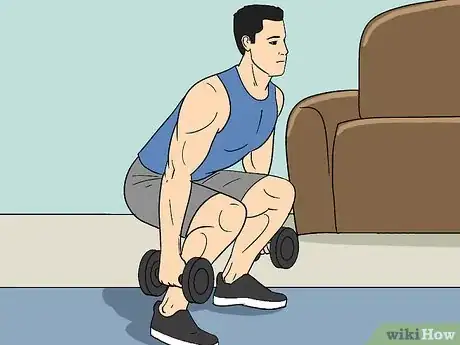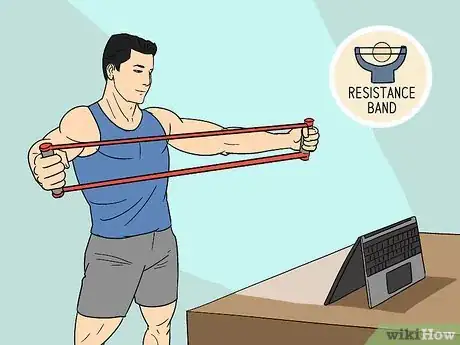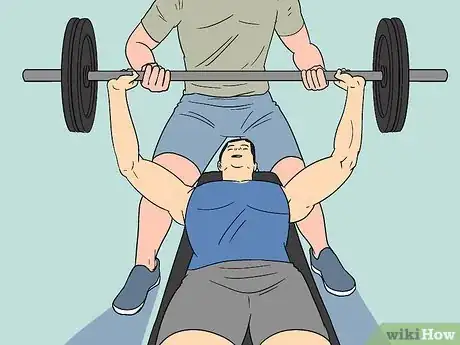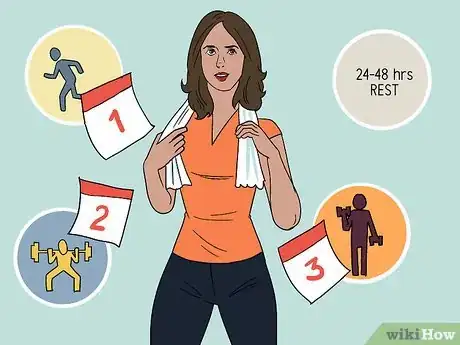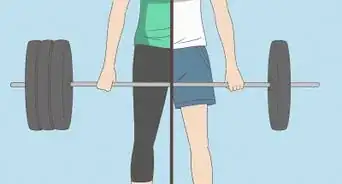This article was co-authored by Kristi Major. Kristi Major is an ACE (American Council on Exercise) certified Personal Trainer based in the San Francisco Bay Area. Kristi has over 18 years of personal training experience and more than 90 hours of recertification study in fitness, health, nutrition, and supplementation. She is CPR and AED certified from the American Heart Association and she has a BA in Television Broadcasting.
There are 14 references cited in this article, which can be found at the bottom of the page.
This article has been viewed 56,016 times.
Weight training is an excellent way to improve your strength, conditioning, and overall health. However, lifting weights improperly can cause injuries that put you out of commission while you heal. Avoid problems by designing an effective training schedule. Plan at least 1 workout per muscle group to keep your body balanced. When you exercise, focus on using proper form and light weights in the beginning. Keep your muscles healthy by giving them at least 24 hours of rest between workouts and eating a balanced diet high in lean proteins.
Steps
Developing an Effective Workout Plan
-
1Ask your doctor if you’re healthy enough for a weight-training regimen. This is especially important if you haven’t exercised much in the past. Strength workouts put a lot of stress on your muscles, joints, and heart, so always get approval from your doctor before starting a workout regimen.[1]
- Have a full physical to check what kind of shape you’re in. Continue having an annual physical to monitor your fitness level.
-
2Schedule a strength-training workout at least twice a week. If you work out less than this, you won’t build much muscle mass. Plan out which muscle groups you’ll work on each day. Alternate between training different muscle groups on different days. Stick with your schedule to see the best results.[2]
- Schedule in at least 24 hours of rest for each muscle group. For example, if you work your back and biceps one day, work your chest and triceps the next day.
- Staying consistent with your workout schedule also helps prevent injuries. If you remain sedentary and workout infrequently, your muscles will be shocked when you start exercising. This can cause pulls and tears.
Advertisement -
3Plan at least 1 workout for each major muscle group. All the muscle groups in your body work together, so only training one leaves your body unbalanced. Imbalances can cause injuries because the weaker muscle groups have to work harder to compensate. Avoid imbalances by training all your major muscle groups. Schedule at least 1 workout for each muscle group per week. Then target other muscles after setting this baseline.[3]
- Pay special attention to your back and core. These muscles support your whole body. Even if you only want bigger arms, you need the core to support the weight you’re lifting.
- You can still focus on building mass in individual muscle groups, as long as you don’t neglect the other muscle groups. If you want bigger biceps, for example, do 3 bicep workouts per week but also include 1 workout for your back, core, triceps, and legs during the schedule too.
EXPERT TIPKristi Major is an ACE (American Council on Exercise) certified Personal Trainer based in the San Francisco Bay Area. Kristi has over 18 years of personal training experience and more than 90 hours of recertification study in fitness, health, nutrition, and supplementation. She is CPR and AED certified from the American Heart Association and she has a BA in Television Broadcasting.ACE Certified Personal Trainer
 Kristi Major
Kristi Major
ACE Certified Personal TrainerUse weight training to increase bone and ligament density. Weight training strengthens your bones, ligaments, and tendons and helps with balance control. If you're doing a full range of motion during strength training exercises, you'll also increase your flexibility.
-
4Keep track of your progress. Write down the date of your workout, each exercise you did, and how much weight you used. Also note if a certain weight was hard or too easy and adjust accordingly. Refer back to this log to plan your future workouts.[4]
- Some people like to carry a notebook at the gym and record their exercises as they do them.
- There are also apps and programs that track your workouts. Check some of these out to help measure your progress.
- If you ever get discouraged that you’re not making enough progress, turn your log back to the first page to see where you started. If you’ve been exercising consistently for several months, you’ll almost certainly be lifting a lot more weight than you were at the beginning. Use this for motivation whenever you’re frustrated.
Staying Safe at the Gym
-
1Keep your back straight while doing squats or deadlifts. If you do a heavy, weight-bearing exercise like a squat or deadlift, keep your back straight to avoid injuries. Bend down by pulling your hips backward, not by bending your back. Use this principle whenever you lift weights.[5]
- Do a few squats in a mirror and watch the way your back moves. Keep it bent at its natural curve and don't bend over. Use this as your reference position for lifting weights.
-
2Use a leg press machine to build leg muscles safely. If you want to build your legs with less risk of injury, a leg press machine is the best option. Start by using the machine with no weight on it to see how it feels. Then slowly add weight in 25 lb (11 kg) increments until it feels comfortable for you.[6]
- Avoid fully extending your knees so you don't stress your joints.
- Remember to set the safety bar at a comfortable height. Leg press machines have built-in bars that stop the weight from falling past a certain point. If the default setting is too low for you, adjust it higher.
-
3Work on an assisted pull up machine to avoid pulling your back. Unassisted pull ups put a lot of stress on your back and can cause muscle pulls. Gyms usually have assisted pull up machines. On these devices, you place your knees on a platform that partially supports your weight while you pull up. Try these machines out to build your back and bicep muscles safely.[7]
- Start with the assistance level high at first to see how the machine feels. Then gradually lower it until it reaches a level that you're comfortable at.
-
4Exhale as you lift and inhale as you release. Holding your breath while lifting tenses your muscles and could lead to pulls. Whenever you lift, keep a steady breathing pace. Inhale as you release or lower the weight, then exhale as you lift it. This keeps your circulation up and your muscles loose.[8]
- During a curl, for example, inhale as you lower the dumbbells, and exhale as you raise them to your shoulders.
-
5Increase the weight when your body is used to it. Let your body tell you when it’s time to scale up. When you’ve been using a certain weight with good form and it feels easy, then it’s time to increase the weight. Work up in small increments. Add 5–10 pounds (2.3–4.5 kg) at a time until you find a new comfortable weight. Then stick with that weight until you can lift it easily.[9]
- If you can do 10-12 reps with a weight easily, then increase it.
- Refer back t your log to see what weights you were using for each workout. This prevents you from scaling up too much.
- Don’t set a time limit on increasing your weight. Committing to increasing once a month might sound good, but a certain weight might still feel heavy for you. Scaling up would be dangerous in this case. Let your body tell you when you’re ready to scale up instead.
-
6Consult a personal trainer if you’ve never lifted weights before. Correct form is crucial for avoiding injuries during a weight-training program. If you don’t know how to do certain workouts, ask a trainer for help. With just one session, a personal trainer can show you the right form for several different exercises, plan a workout schedule, help develop your goals, and make suggestions for your diet. It’s an investment worth making if you’re serious about working out effectively.[10]
- Some gyms have trainers on staff that provide free consultations. Take advantage of this resource if your gym has it.
- There are also many videos online where people show the correct form for certain exercises. Refer to these if you don’t have access to a trainer.
- Be cautious when taking advice from friends or family. Just because someone is into exercise doesn’t mean they use proper form. Only take advice from someone certified.
-
7Continue using proper technique when moving weights around. Don’t get lazy after your workout is done. Always carry plates, dumbbells, and barbells correctly when you’re moving or restacking them. This is an easy way to avoid injuries during your workout.[11]
- Don’t focus all the weight on your back while carrying something. Use your legs and hips to support it.
- Use smooth motions when you pick something up. Don’t jerk it up quickly.
-
8Use a spotter if you’re lifting heavy weights. Spotters help you raise heavy weights up into position for your workout and lower them when you’re finished. They also stand by to help if the weight is too heavy and you get stuck. If you’ve advanced to the point that you’re doing heavier lifts, keep yourself safe by working with a spotter.[12]
- A spotter is especially important if you’re doing a workout with weight above your head or chest, like a bench press, shoulder press, or dumbbell press.
- If you workout with a friend, the two of you can spot each other. If you work out alone, ask someone nearby to spot for you. Most people are happy to help out.
Working Out at Home
-
1Touch your elbows to your body during bicep curls. Generally, the further a weight is from your body, the more you have to strain to lift it. During bicep curls, for instance, pushing your elbows away from your body makes your back work at an odd angle. This could lead to strains and pulled muscles. Keep your elbows tucked to your body for a safer motion.[13]
- As an added bonus, keeping your elbows tucked isolates your biceps more and gives them a better workout.
- Use this principle during other strength workouts as well. Keep the weight close to your body to prevent straining your back.
-
2Do squats with dumbbells at home. You can squats at home just like at the gym, but with a minor adjustment. Hold dumbbells instead of a barbell. Use the same form as you would at the gym to prevent back injuries. Keep your back straight and bend from your hips.[14]
- Don't overload yourself with very heavy dumbbells. Choose a weight that's comfortable and lets you maintain the proper form.
-
3Scale up the weight slowly to prevent injuries. Just like when you workout at the gym, increase the weight slowly when you workout at home. Wait until you can do 10-12 reps of each workout comfortably. Then increase the weight in small increments at a time.[15]
- Refer back to your workout log to plan your weight increases. Only scale up by about 10 pounds (4.5 kg) at a time.
-
4Use resistance bands instead of weights to avoid overexerting yourself. Almost all weight exercises can be done with resistance bands too. These offer less resistance than weights, and are less likely to injure you. If you're just starting out or are worried about getting injured, convert your favorite workouts to use resistance bands instead.[16]
- For most workouts, wrap the band around a pole or step on it with one foot. Then use your arms to pull and release them.
- Look on the internet for videos that show popular resistance exercises. Copy them to use the correct form.
- Resistance workouts are also convenient to do at home.
-
5Invite a partner over to workout in pairs. Having someone nearby is important to help out if you do get injured. Consider inviting a friend over to workout with you. The two of you can spot each other and comment on each other's form. It's the same as working out with a spotter at the gym.[17]
- Have your partner pay particular attention to your form. They can watch you from different angles and make sure you're using the correct form for all your workouts.
- Motivate each other too. Working out with a partner can be a great way to boost your energy.
Caring for Your Muscles
-
1Warm up thoroughly before exercising. A good warmup is especially important before lifting weights. Spend 10-15 minutes doing some light cardio and stretching before your workout. This gets your muscles ready for a strength workout.[18]
- Good warmup activities are brisk walking, jogging, and jumping rope. As a general rule, warm up enough so you break a sweat.
- Follow your warmup with a good stretching routine. Focus on the muscle groups that you’ll be training that day.
-
2Use proper form for every workout you do. For strength workouts, form is more important than weight. Improper form can lead to injuries and subpar results. Different workouts use different forms, so spend some time learning the right way to do each workout you perform. Then workout slowly and focus on form whenever you start a new exercise.[19]
- Work out in front of a mirror in the beginning to watch your form. Then build your muscle memory to the point that you don’t need the mirror anymore.
- Even if you’re experienced, don’t get lazy with your form. Always focus on using correct technique.
-
3Start off doing exercises with light weights. Never start a new workout with a lot of weight. Your body isn’t used to the exercise yet and you could pull a muscle. Instead, start small and focus on your form. As a general rule, use a light enough weight to do 15 reps comfortably when you start a new workout. Then scale up when you get used to the weight.[20]
- If you’re doing a workout and you can’t use the proper form, then the weight is probably too heavy. Cut the weight in half and try again. Then work up to a comfortable weight where your form stays clean.
- For barbell activities like squats and deadlifts, do a few reps with the bar empty to get used to the form. For other activities, use light dumbbells and plates.
-
4Exhale as you lift and inhale as you release. Holding your breath while lifting tenses your muscles and could lead to pulls. Whenever you lift, keep a steady breathing pace. Inhale as you release or lower the weight, then exhale as you lift it. This keeps your circulation up and your muscles loose.[21]
- During a curl, for example, inhale as you lower the dumbbells, and exhale as you raise them to your shoulders.
-
5Stay hydrated during and after your workout. Dehydration causes your muscles to tense up. During a weight-training regimen, this can result in pulls and tears. Always drink plenty of water before, during, and after a workout to prevent dehydration and keep your performance up.[22]
- Drink 17-20 oz. (0.5-0.59 L) before your workout, then 7-10 oz. (0.2-0.29 L) for each 20 minutes of exercise. Then drink another 17-20 oz. (0.5-0.59 L) after your workout ends.
- As a general rule, drink enough water so your urine is bright yellow and you don’t feel thirsty.
-
6Cool down after your workout. Stopping your workout suddenly can cause your muscles to tighten up, leaving you sore the next day. Avoid tightness and strains with a good cool down routine. Spend 10-15 minutes walking or jogging to gradually lower your heart rate. Focus on deep breathing to relax your muscles.[23]
- Do another stretching routine after your cool down. Focus on the muscle groups you trained that day.
-
7Rest muscle groups for 24-48 hours before training them again. Although it’s tempting to work out as much as possible, building muscle requires rest. Give each muscle group a full day of rest before working it out again. Stagger your schedule so you don’t train the same muscle groups 2 days in a row.[24]
- If you want to do some exercise every day, try going for a run or riding your bike on a day when you aren’t lifting. This builds your conditioning while also giving major muscle groups a break.
- Also schedule 1 or 2 total rest days per week. Do only light activities like walking on these days.
- Don’t be afraid to take a day off if you’re sick. You could hurt yourself if you exercise when your body isn’t healthy.
-
8Eat a balanced diet high in lean proteins. Your muscles need fuel for energy and to repair themselves. Eat 3 balanced meals per day with some healthy snacking in between. Make sure each meal contains a good serving of lean proteins, vitamins, and complex carbohydrates.[25]
- Include 50-60 grams of protein in your daily diet. Good sources of lean proteins are fish, poultry, beans, avocados, and nuts. Red meat also provides protein, but it’s higher in saturated fat. Limit your red meat intake to 1 or 2 servings per week.[26]
- Also include servings of vitamin A, B, and C in your diet to keep your immune system healthy. Mix fruits, green leafy vegetables, bell peppers, carrots, and sweet potatoes into your meals for added vitamins.[27]
- For complex carbohydrates, replace all your white bread and rice with whole wheat versions.
-
9Stop exercising if you feel pain in your joints. Some discomfort is common when you exercise, but joint pain is a bad sign. You may be using a weight that’s too heavy or injured yourself. Whenever you feel joint pain, put the weight down smoothly. Don’t try to finish the set or push through the pain.[28]
- Try the workout again with a lighter weight. Focus on using the correct form.
Warnings
- Don’t try to “max out” weights by lifting a very heavy weight once or twice. This overloads your body and can cause muscle pulls or tears.⧼thumbs_response⧽
References
- ↑ https://orthoinfo.aaos.org/en/staying-healthy/starting-a-strength-training-program/
- ↑ https://orthoinfo.aaos.org/en/staying-healthy/starting-a-strength-training-program/
- ↑ https://orthoinfo.aaos.org/en/staying-healthy/starting-a-strength-training-program/
- ↑ https://www.bodybuilding.com/fun/topicoftheweek43.htm
- ↑ https://www.mayoclinic.org/healthy-lifestyle/fitness/in-depth/weight-training/art-20045842
- ↑ https://www.verywellfit.com/how-to-use-weight-machines-and-gym-equipment-4153575
- ↑ https://www.verywellfit.com/how-to-use-weight-machines-and-gym-equipment-4153575
- ↑ https://www.mayoclinic.org/healthy-lifestyle/fitness/in-depth/weight-training/art-20045842
- ↑ https://www.bodybuilding.com/content/best-beginner-weight-training-guide-with-easy-to-follow-workout.html
- ↑ https://familydoctor.org/weight-training-and-weight-lifting-safety/
- ↑ https://familydoctor.org/weight-training-and-weight-lifting-safety/
- ↑ https://familydoctor.org/weight-training-and-weight-lifting-safety/
- ↑ https://www.military.com/military-fitness/weight-training/how-to-lift-weights-safely
- ↑ https://www.bodybuilding.com/exercises/dumbbell-lunges
- ↑ https://www.bodybuilding.com/content/best-beginner-weight-training-guide-with-easy-to-follow-workout.html
- ↑ https://www.military.com/military-fitness/weight-training/how-to-lift-weights-safely
- ↑ https://familydoctor.org/weight-training-and-weight-lifting-safety/
- ↑ https://www.health.harvard.edu/exercise-and-fitness/7-tips-for-a-safe-and-successful-strength-training-program
- ↑ https://www.health.harvard.edu/exercise-and-fitness/7-tips-for-a-safe-and-successful-strength-training-program
- ↑ https://www.bodybuilding.com/content/best-beginner-weight-training-guide-with-easy-to-follow-workout.html
- ↑ https://www.mayoclinic.org/healthy-lifestyle/fitness/in-depth/weight-training/art-20045842
- ↑ http://www.med.umich.edu/1libr/Mhealthy/TheImportanceofWaterWhileExercising.pdf
- ↑ https://kidshealth.org/en/teens/strength-training.html
- ↑ https://www.health.harvard.edu/exercise-and-fitness/7-tips-for-a-safe-and-successful-strength-training-program
- ↑ https://www.choosemyplate.gov/ten-tips-build-healthy-meal
- ↑ https://www.health.harvard.edu/blog/how-much-protein-do-you-need-every-day-201506188096
- ↑ https://www.health.harvard.edu/staying-healthy/best-source-of-vitamins-your-plate-not-your-medicine-cabinet
- ↑ https://www.mayoclinic.org/healthy-lifestyle/fitness/in-depth/weight-training/art-20045842




